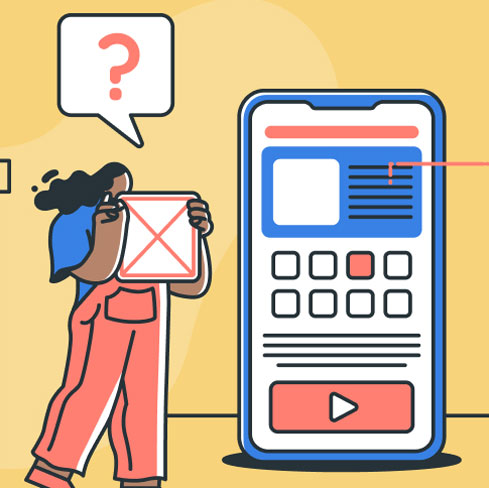UX Research methods
November 6, 2018 | Read Time : 3 mins
Table of Contents
User Experience (UX) design is all about enhancing the overall experience that users have when they interact with a certain product. UX design ensures that consumers find joy, satisfaction, and value when using your business’s products.
The design process doesn’t have to be a guessing game. UX research is the key that unlocks user needs and transforms a seemingly impossible task into an attainable, valuable goal that exceeds expectations. After all, you can’t design a product that consumers will love if you don’t know your audience, right?
Listed below are some comprehensive research methods employed by UX companies to help them craft an unforgettable experience.
The Best UX Research Methods
Card Sorting
Card sorting refers to a research method where participants of a sample group organize a website’s information into logical categories that will help make website navigation more user-friendly. The process involves designing or improving the information architecture (IA) of a platform to make it more intuitive.
In the research process, the participants will be prompted to organize a set of topics into categories that make sense to them. The topics may be written on actual cards, paper, or an online platform may be used. The respondents can also help name these categories better, or give their suggestions.
This research method is primarily used to understand how users perceive various topics and what their expectations are. Card sorting can be further classified into open and closed or tree-test, depending on whether you ask them to label the groups or ask them to segregate the topics into pre-defined groups, respectively.
Contextual Interviews
A contextual interview is a UX research technique that involves the observation of users in their natural environment, as opposed to completing tasks in a controlled space like a lab. This method is less formal and doesn’t utilize scripts, tasks, or lab tests.
As a result, these interviews sometimes give more realistic qualitative data as they’re based on observations and not measurements. This type of research method helps UX researchers better understand variables like issues being faced, the set-up of the users’ space, personal preferences, time taken to complete targeted tasks, any extra support they may require, and more.
First Click Testing
This is yet another method that focuses on navigation and measuring the usability of websites or applications. To build a successful platform, it is crucial to take the users’ tasks into account. Research has concluded that participants who click on the right part from their first click, are 87% more likely to complete their task successfully.
First Click Testing explores and analyzes what test participants click on first while navigating through the given interface, to complete the intended task. A wireframe, prototype, or pre-existing website or app can be used for testing.
This UX research method is employed to help businesses evaluate the effectiveness of their platform’s linking structure, including navigation and uptime. It also examines how easy it is for users to interact with the platform.
Focus Groups
A focus group refers to a moderated discussion with a sample group, and typically involves five to ten participants. A focus group helps UX researchers gain salient insights into the participants’ attitudes, needs, and perceptions.
It differs from a contextual interview in that it is more formal and in a controlled setting. Since the participants of a focus group talk to the researchers directly, there’s no way to verify or observe their experiences, unlike the former, where conclusions are drawn from first-hand observations.
Heuristic Evaluation or Expert Reviews
A heuristic evaluation focuses on the usability of your platform. The term “usability” refers to quality factors including memorability, user satisfaction, and learnability, to name a few. In this evaluation process, one or more experts compare your digital product’s design with a set of predefined, recognized UX design principles, called heuristics.
The evaluators then identify the gaps where the platform is not adhering to these principles, and give each identified usability issue a “severity rating”. The UX designers then tweak the platform based on the most critical ratings, and therefore, improve its overall usability and efficiency.
Parallel Design
Parallel design refers to a design methodology where several UX designers work on the same design problem simultaneously, to produce the best possible outcome. An initial design is therefore created by individual designers using the same set of variables and requirements.
Then, once the independent brainstorming is complete, the design team takes into account each solution, and the best ideas are utilized to create the final solution. The parallel design process sows the seeds for several creative design ideas.
This method helps generate a range of diverse ideas cost-effectively and quickly, and since multiple avenues to the same goal are explored at the same time, the concept development schedule is compressed.
Personas
As the name implies, personas are fictional representations of different people who can be created from the data you have at hand. This UX research method helps represent the various user types who may use the platform offered by your brand or business.
Since creating a focus group of the ideal target audience is not always possible, creating personas help researchers better understand the consumers’ needs, expectations, goals, experiences, and behaviours.
Essentially, personas add a human touch to what would otherwise remain cold, hard facts that would be tough to relate to. This research technique is usually applied during the Define phase of the design thinking process where the data from the previous stage is synthesized.
Creating personas offer meaningful archetypes that help researchers recognize that different users have unique expectations and needs. This helps them identify with and relate to the target audience. This ultimately leads to the goal of crafting an excellent user experience for them.
System Usability Scale
The System Usability Scale or SUS, in short, has become an industry-standard, ever since the method was devised in 1986. This reliable, technology-independent tool gauges a platform’s usability, through a 10 item questionnaire that has five response options for each question. The options range from “Strongly Agree” to “Strongly Disagree”, or any similar variation of this scale.
The SUS enables researchers to rapidly evaluate an array of diverse services and products, including websites, applications, software, and hardware. Its most notable benefits are that it is a simple scale that can be given to all participants and it offers reliable results even with small sample sizes.
The SUS can also effectively distinguish between unusable and usable systems. It is important to note that this is not a diagnostic tool, but can only be used as a classification tool, based on the usability of the system being tested.
Summing It Up
User Experience (UX) is a subjective field, and the experience a person goes through while using a platform varies from one target group to another. Selecting the right UX research method, or a combination of them, helps researchers collect, analyze and apply invaluable data to a platform or product.
At the end of the day, this helps craft a product that serves both businesses and consumers more efficiently, leaving a lasting impact on them. It can therefore be said that user research is at the very core of designing an exceptional, impressive user experience, for all UX design companies, including Origin UX.






